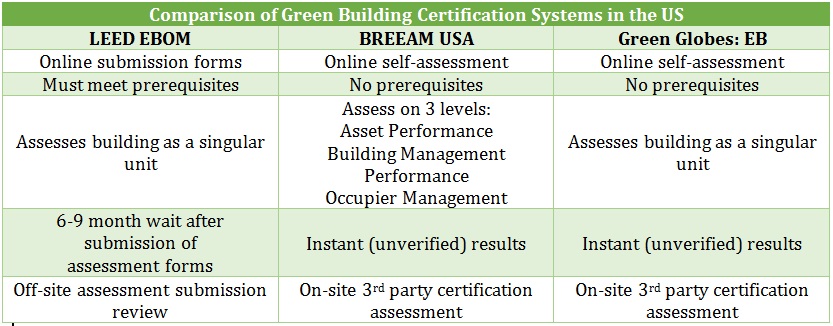by Mayra Portalatin and Sean McWilliams — August 2016
Introduction
Green building certification has been a way for building owners and facility managers to demonstrate that they have sustainable and energy efficient operations. There are many building certifications around the world which have been created to meet the regional needs of the buildings in those areas, and the US is no different. While for many years the United States Green Building Council’s (USGBC) Leadership in Energy & Environmental Design (LEED) Building Certification has been the only US-centric rating system available, more options have now emerged. In 2004, the Green Building Initiative (GBI) adapted Green Globes, the Canadian web-based, interactive learning tool, to the needs of US commercial buildings. More recently, BuildingWise and the Building Research Establishment (BRE) modified the Building Research Establishment Environmental Assessment Method (BREEAM) to fit the US needs in the form of BREEAM USA. While certification is not a requirement for US buildings, the availability of more building rating systems certainly provides more opportunities for building owners and facility managers to certify their buildings to show that they are doing their part to be a corporate socially responsible organization.
LEED for Existing Buildings: Operations & Maintenance
LEED for Existing Buildings: Operations & Maintenance (LEED EBOM) was first established as LEED for Existing Buildings (LEED-EB) in 2002 to provide a platform for existing buildings to demonstrate sustainable operations. It was rebranded to its current moniker in 2009, and has over 4,000 certified buildings since its inception.
In order to certify under the LEED rating system, a building must first meet twelve prerequisite benchmarks and at least 40 credits across assessment categories. While meeting the prerequisites is not an impossible task, the increase in the minimum energy performance requirements make it a difficult hurdle for some buildings to achieve without putting some considerable effort and capital investment into energy conservation measures. While this may keep the number of certified buildings under the LEED EBOM rating system less than LEED’s other certifications, buildings that certify under LEED EBOM and continue with their green policies past their initial certification typically see a substantial reduction in their water and energy usage. According to a 2012 IFMA survey, LEED certified buildings saw, on average, a 40% energy savings and a 66.5% water savings.
LEED certified buildings see significant benefits compared to uncertified buildings. As reported by the USGBC, existing building projects saw an operational cost decrease of 8.5%, an increase in building value by 6.8%, and a 4% increase in asset valuation. A study of the productivity and health benefits of LEED certified buildings’ environmental factors shows significant improvements. Outside views are attributed to 10-25% better mental function and memory, 6-12% faster call processing, and 8.5% shorter hospital stays. Daylighting is attributed to students receiving 5-14% higher test scores and learning 20-26% faster, workers being 18% more productive, and a 15-40% increase in retail sales.
From beginning to end, the timeline for LEED EBOM certification is heavily dependent on the size of the project and how much you have to do in order to meet the minimum requirements. This can be anywhere from several months to years. At a minimum, you’ll need to show a three-month performance period (with some credits requiring data for at least 12 consecutive months). The cost to certify (not including the cost to implement projects) can range anywhere from $3,200 to $22,000 (registration and certification review fees) depending on building size and membership status with the USGBC. To show continued sustainable operations, you can re-certify under LEED EBOM (required to be done within five years of initial certification). If you do not re-certify within the five years, you can submit for certification (like if it was the first time). In order to make re-certification easier, USGBC has created the LEED Dynamic Plaque, which allows building owners to monitor and measure their building performance in a continuous manner with re-certification possible on an annual basis.
LEED EBOM
Green Globes for Existing Buildings
Green Globes entered the existing building market in the US back in 2004 through the GBI. Since then, the GBI has certified over 400 existing buildings in the US and its territories. Green Globes is a modified form of BREEAM that was introduced in Canada before the GBI acquired the US rights and introduced it as a competitor for LEED. While it has maintained a small profile in the grand scheme of US green building certification, Green Globes was recently elevated in status in 2013 when the GSA selected it and LEED as recommendations to the Department of Energy (who approved it in 2014) for third party certifications for the federal government. Green Globes was the first commercial building rating system based on an American National Standard (ANSI).
Unlike the LEED system, Green Globes has no prerequisites, which makes it more accessible to buildings for which meeting LEED’s minimum requirements was difficult. This means that reported savings may be smaller in comparison. The 2012 IFMA survey found that Green Globes certified buildings reported a 14% average energy savings and 35% average water savings. The tradeoff lies in the time, money, and effort required to certify under each system. The GBI estimates that it takes about 39-77 work hours to complete the certification process, not including the time it takes to implement planned green projects.
Green Globes is marketed as a cheaper and simpler approach to green building certification. A registration fee grants building owners access to a web-based self-assessment tool that will give personalized feedback and recommendations for the building. Facility managers can then use the feedback and recommendations to plan projects to improve the building before final assessment. There are 1000 points to be awarded in the Green Globes certification, with a minimum of 35% needed to achieve one globe.
Green Globes for Existing Buildings
BREEAM USA
While BREEAM is the oldest and biggest name in green building certification on the international scale, BREEAM USA is a brand new player in the US market. BREEAM USA uses the BREEAM In-Use certification standard that has been widely used internationally. Since 2008, BREEAM In-Use has awarded over 2,000 certifications worldwide.
BREEAM USA shares many similarities with Green Globes as Green Globes is a derivation of BREEAM. Like Green Globes, BREEAM USA has no prerequisites and is, therefore, open to many more buildings across the country. Buildings are assessed at 3 separate levels and can be certified individually at each the asset, building management, and occupier management levels. An Acceptable certification rating (one star) can be achieved if you meet a minimum 10% of the certification criteria.
Schneider Electric certified their building, Le Hive, in Paris through the BREEAM In-Use system for all 3 levels. They achieved an Excellent rating for the first part, and Outstanding for parts two and three. In three years being certified under BREEAM, Le Hive managed to reduce their energy consumption by 50% and meet the French 2020 target for greenhouse emissions reduction.
The BREEAM USA system has an online self-assessment tool that provides feedback and recommendations towards meeting a desired level of certification. Building owners can gain access to the tool for a $1,000 registration fee. Certification costs will vary by building size and third party certification fees.
BREEAM In-Use
The following tables show comparisons between the three ratings systems available in the US.
Is Certification my Only Option?
Certifying a building as green can be a lengthy and costly process. While there are ongoing efforts to make it more accessible and to reduce the overall cost of the certification and recertification process, price is still a hurdle for many who wish to show that they are running a sustainable and energy efficient operation. But do we have to certify a building? You may get a directive from your CEO that they want to certify a building, or perhaps it is a goal of the organization to show their social corporate responsibility, but ultimately, there is currently no law in the United States that forces anyone to certify their building. While the federal government mandates that any of their new buildings must be built to a LEED Silver, Green Globes, or equivalent level, it does not require for the building to actually be certified. This introduces the concept of the “all but certified” (ABC) route.
The concept of “all but certified” is to pursue the standards of a green certification without actually receiving the certification. Because guidance for these systems are available to users (generally at little to no cost), building owners or managers can use the existing building rating systems as a guide to enhance their building’s performance without spending the additional money on consulting, 3rd party assessor, and certification fees which can range from $20,000 to $100,000 (depending on building size and project scope). An example of this can be seen in the Urban Ecology Center in Milwaukee. While they performed well enough to certify under LEED for New Construction, they decided to forego the process because it would have tacked on a significant cost that they did not wish to endure.
No matter what you choose (to certify or not), the case can be made that using rating systems to help you achieve sustainable and energy efficient operations will help you save money through reduced utility bills and reduced waste bills through increased waste diversion, to name a few. It also helps promote a better work environment, which helps with retention of employees and increased productivity.
Authors:
 Mayra Portalatin is a Civil & Environmental Engineer with over 18 years of consulting experience in the built environment ranging from condition assessments to sustainability audits. She has presented on the subject of sustainability and the built environment to property and facility managers in various venues including Greenbuild and IFMA’s World Workplace. Mayra is also an IFMA instructor for the Sustainability Facility Professional certification and teaches FM Technology in Catholic University’s Facility Management Master’s Program.
Mayra Portalatin is a Civil & Environmental Engineer with over 18 years of consulting experience in the built environment ranging from condition assessments to sustainability audits. She has presented on the subject of sustainability and the built environment to property and facility managers in various venues including Greenbuild and IFMA’s World Workplace. Mayra is also an IFMA instructor for the Sustainability Facility Professional certification and teaches FM Technology in Catholic University’s Facility Management Master’s Program.
 Sean McWilliams is currently working on his Bachelor’s in Mechanical Engineering at Temple University with graduation projected for May 2017. Sean already has an Associate of Science with Honors in Engineering and has been working as an intern at Facility Engineering Associates during the summer of 2016.
Sean McWilliams is currently working on his Bachelor’s in Mechanical Engineering at Temple University with graduation projected for May 2017. Sean already has an Associate of Science with Honors in Engineering and has been working as an intern at Facility Engineering Associates during the summer of 2016.




